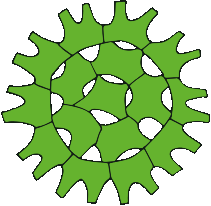This sure looks good:Nordic Microalgae
Read More
Month: September 2011
Blue-greens in České Budějovice
It's already a month ago, that I was on the Determination Course of Freshwater and Terrestrial Cyanobacteria in Czech Republic, in this beautiful city of České Budějovice, about 150 km south of the ever so wonderful city of Prague.We had a very intensive and highly interesting week going through the newest developments in the taxonomy of Cyanobacteria, under the kind and inspiring guidance of Prof. Komárek the Great: You could also get individual lessons: (Thank you for the photo, Oriana!)Here is our wonderful Cyanobacteria group all together on the market place of České Budějovice:(Sorry, don...
Read More
The other way round
With an up-right microscope one puts the slide the other way round on the stage than when using an inverted microscope. I should know it by now... But I was becoming a bit desperate while calibrating the 40x PlanApo Oil objective on my up-right Zeiss microscope and I did not get the stage micrometer sharp. The 10x objective showed the lines alright. So why not the 40x objective?? Did the micrometer move with the oil? Should I turn the objective just a little bit closer? Afraid of breaking either the micrometer or - even worse - the objective, I was becoming quite anxious.And then it struck me....
Read More
Home of Staurastrum sexcostatum
Was on my last sample trip last Sunday and took some water out of the ditch, near to my favorite lake. And this is what I found:Size 38x48 µm. Lots of them. Seems to be the home of Staurastrum sexcostatum Brébisson ex Ralfs 1848. According to Coesel & Meesters (2007) it particularly occurs in ephemeral pools. Might well be, that this ditch gets dry in the summer. In the Netherlands it's rare, Coesel and Meesters state. The same thing is told us by John and Williamson (2009) and they are referring to West of Ireland. Lenzenweger (1997) let's us know that this species has been but rarely found i...
Read More
Immersion oil
My Zeiss immersion oil ran out. No worries, I had another one. This one was Olympus. And as it turned out, a bit thinner. And viscosity of immersion oil is quite a critical characteristic when using an inverted microscope. On the bottles I can't find any kind of direct information about the viscosity, strange enough. The refractive index is mentioned, though. Also a very critical phenomenon. Zeiss had it 0,002 higher than Olympus. That shall not make the difference. Again, while visiting the Netherlands, my dear colleague and a the Great Microscope Man René van Wezel told me a thing or two abo...
Read More
Connected
I'm now connected to the EnvPhyto phytoplankton counting program that runs at the Finnish Environment Institute in Helsinki. :) EnvPhyto is again connected with the national environmental database, Hertta. This together makes it possible to combine the algae count results with the known environmental parameters of the lake, like depth, catchment area, pH, P, N etc etc. At once.
Read More
Navicula reinhardtii
While visiting my colleagues in the Netherlands we discussed this peculiar Navicula from the Dutch waters, that I was not able to give a name to. Geurt Verweij - a far more competent diatomist than I ever will be - gave his opinion on the subject: Navicula reinhardtii. Size= 15 x 34 µmI had seen this little fellow many times. The structure in the middle of the scale is quite special, with long an short striae. Geurt pointed out, that the end of the raphe is curved. Yes, I could see that. And, what's even more specific is that the other end is curved to the opposite direction. Seems to be ...
Read More
